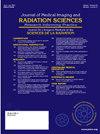To Ring or Not To Ring
IF 2
Q3 RADIOLOGY, NUCLEAR MEDICINE & MEDICAL IMAGING
Journal of Medical Imaging and Radiation Sciences
Pub Date : 2025-05-01
DOI:10.1016/j.jmir.2025.101948
引用次数: 0
Abstract
Purpose/Aim
At the end of a course of cancer treatment (chemotherapy, radiotherapy or other) patients are sometimes given the option to ring a bell to celebrate treatment completion. This is widely done across cancer centers in Canada. The act of ringing a bell is generally intended to give patients a sense of closure, but despite best intentions there are many patient concerns that have begun to reach the scarce literature. Patient opinion pieces have described the bell ringing as divisive, reminding them of their own never-ending journey. Additionally, prospective studies have found increased distress in patient groups who rang the bell versus those who did not. The aim of this project was to find and implement a more private and inclusive means of celebrating the end of a course of radiation treatment.
Methods/Process
To start, cancer centers across Canada, Australia and the UK were surveyed to discover what methods of celebration were being used globally in addition to any feedback they had received from patients regarding the bell. All non-bell related options for celebration were gathered with support from the Cancer Patient and Family Engagement platform. From this a patient survey was created for our institution. Patients were surveyed for their opinions and given alternative options to choose from for future use. This survey was then re-opened to increase sample size.
Results or Benefits/Challenges
The benefit of finding a new way to celebrate the completion of a course of radiation treatment is to allow patients a more private means of celebrating that does not impact other patients. The current primary concern with bell ringing is that it can be heard by other patients in the clinic, leading to negative reactions. The challenge of this project will be the implementation process, it may require additional hospital resources and space which is already strained.
Conclusions/Impact
Of the 65 cancer centers polled, 46% used bell ringing, of those, 57% stated they had received some form of negative feedback from patients. After re-opening the survey, 17/56 patients surveyed were given the option to ring a bell at the end of their treatment. 24% chose not to ring, and 20% of those polled did not want to watch or hear others ring a bell. There were many poignant remarks from patients, for example one person stated, “I don't feel the need to see others celebrate - and I know if there comes a time when I will never finish, then I wouldn't want to see that”. When given four alternative options to the bell, most patients voted for an art installation, or a signed card by the treatment team. The results of this project highlight the need to re-examine the bell as an appropriate method of celebration for patients receiving cancer treatment. Our institution has removed the bell and are working towards mounting an art installation for our patient population. We have also shared these results to departments across our provincial cancer care program, who have started taking corrective action. In future, we will conduct follow up surveys or patient focus groups to assess the impact.
打还是不打
目的:在癌症治疗过程(化疗、放疗或其他)结束时,患者有时可以选择按铃庆祝治疗完成。这在加拿大的癌症中心被广泛采用。按铃的行为通常是为了给病人一种结束的感觉,但是尽管有最好的意图,许多病人的担忧已经开始达到稀缺的文献。耐心的评论文章将钟声描述为分裂,提醒他们自己永无止境的旅程。此外,前瞻性研究发现,按铃的患者比不按铃的患者更痛苦。这个项目的目的是寻找和实施一种更加私密和包容的方式来庆祝放射治疗过程的结束。首先,对加拿大、澳大利亚和英国的癌症中心进行了调查,以发现全球正在使用的庆祝方式,以及他们从患者那里收到的关于钟声的任何反馈。所有与钟声无关的庆祝选择都是在癌症患者和家庭参与平台的支持下收集的。据此,我们为我们的机构创建了一份患者调查。研究人员对患者进行了意见调查,并给出了可供将来使用的备选方案。然后重新开始调查以增加样本量。结果或益处/挑战找到一种新的方式来庆祝一个放射治疗过程的完成的好处是允许患者以一种更私人的方式庆祝,而不会影响到其他患者。目前人们对铃响的主要担忧是它会被诊所里的其他病人听到,从而导致负面反应。这个项目的挑战将是执行过程,它可能需要额外的医院资源和已经紧张的空间。结论/影响在接受调查的65家癌症中心中,46%的中心使用铃声,其中57%的中心表示他们收到了来自患者的某种形式的负面反馈。在重新开始调查后,接受调查的56名患者中有17人可以选择在治疗结束时按铃。24%的人选择不摇铃,20%的受访者不想看到或听到别人摇铃。病人们发表了许多令人心酸的评论,比如一个人说:“我觉得没有必要看别人庆祝——我知道如果有一天我永远也完成不了,那我也不想看到别人庆祝。”当给病人四种选择时,大多数病人都选择了艺术装置,或者是治疗团队签名的卡片。这个项目的结果强调需要重新审视铃铛作为接受癌症治疗的患者庆祝的合适方法。我们的机构已经拆除了钟,并正在努力为我们的病人安装一个艺术装置。我们还将这些结果分享给了我们省癌症护理项目的部门,他们已经开始采取纠正措施。未来,我们将进行跟进调查或患者焦点小组,以评估影响。
本文章由计算机程序翻译,如有差异,请以英文原文为准。
求助全文
约1分钟内获得全文
求助全文
来源期刊

Journal of Medical Imaging and Radiation Sciences
RADIOLOGY, NUCLEAR MEDICINE & MEDICAL IMAGING-
CiteScore
2.30
自引率
11.10%
发文量
231
审稿时长
53 days
期刊介绍:
Journal of Medical Imaging and Radiation Sciences is the official peer-reviewed journal of the Canadian Association of Medical Radiation Technologists. This journal is published four times a year and is circulated to approximately 11,000 medical radiation technologists, libraries and radiology departments throughout Canada, the United States and overseas. The Journal publishes articles on recent research, new technology and techniques, professional practices, technologists viewpoints as well as relevant book reviews.
 求助内容:
求助内容: 应助结果提醒方式:
应助结果提醒方式:


